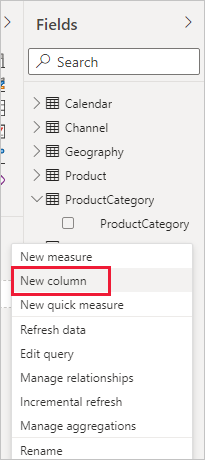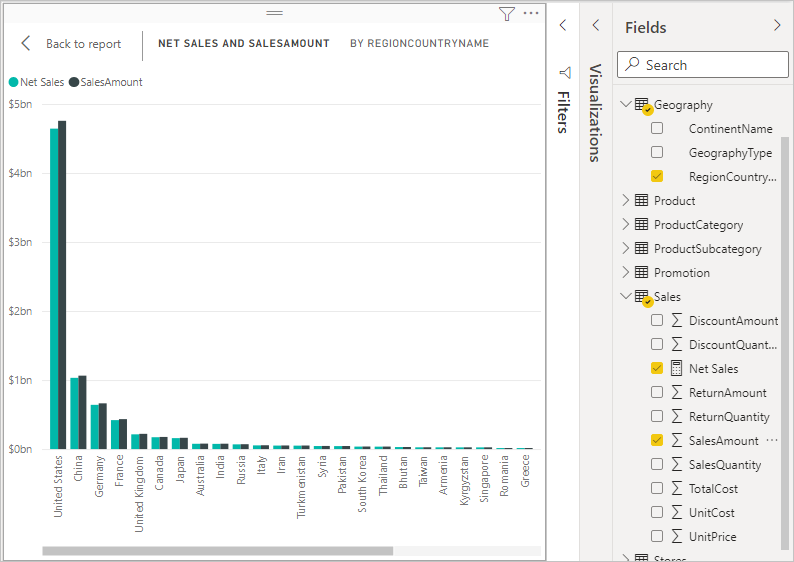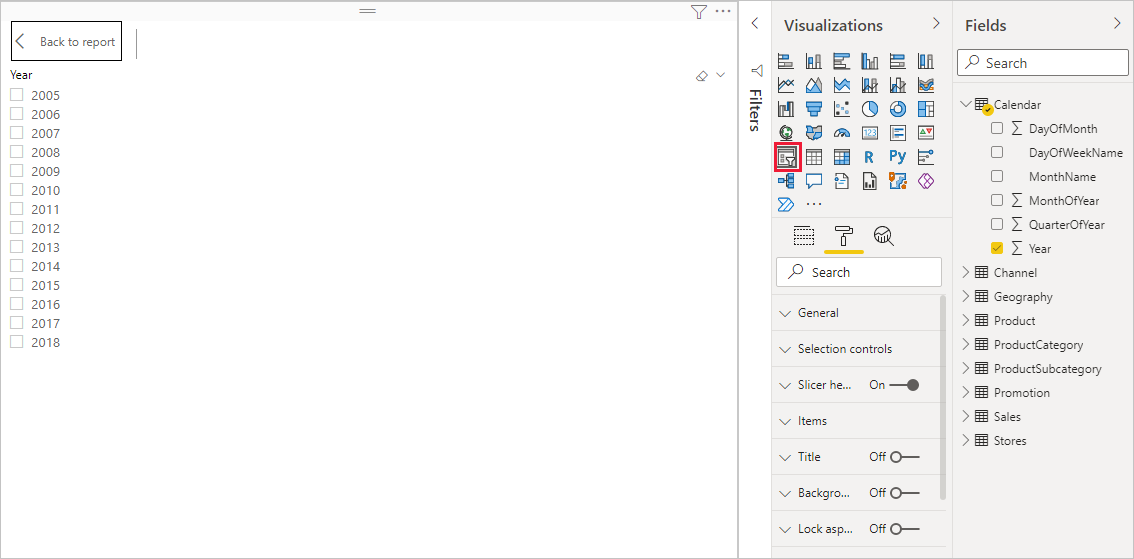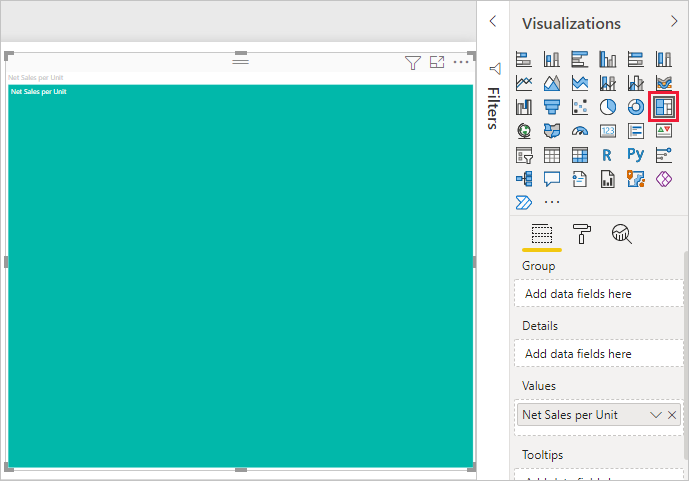OVERVIEW:
MANAGING DATA RELATIONSHIPS:
CREATING CALCULATED COLUMNS:
To create your new column in the ProductSubcategory table, right-click or select the ellipsis ... next to ProductSubcategory in the Fields pane, and select New column from the menu.

When you select New column, the Formula bar appears along the top of the Report canvas, ready for you to name your column and enter a DAX formula.

By default, a new calculated column is named Column. If you don’t rename it, additional new columns will be named Column 2, Column 3, and so on. You want your column to be more identifiable, so while the Column name is already highlighted in the formula bar, rename it by typing ProductFullCategory, and then type an equals (=) sign.
You want the values in your new column to start with the name in the ProductCategory field. Because this column is in a different but related table, you can use the RELATED function to help you get it.
After the equals sign, type r. A dropdown suggestion list shows all of the DAX functions beginning with the letter R. Selecting each function shows a description of its effect. As you type, the suggestion list scales closer to the function you need. Select RELATED, and then press Enter.

An opening parenthesis appears, along with another suggestion list of the related columns you can pass to the RELATED function, with descriptions and details of expected parameters.

You want the ProductCategory column from the ProductCategory table. Select ProductCategory[ProductCategory], press Enter, and then type a closing parenthesis.
You want dashes and spaces to separate the ProductCategories and ProductSubcategories in the new values, so after the closing parenthesis of the first expression, type a space, ampersand (&), double-quote ("), space, dash (-), another space, another double-quote, and another ampersand. Your formula should now look like this:
ProductFullCategory = RELATED(ProductCategory[ProductCategory]) & " - " &Enter an opening bracket ([), and then select the [ProductSubcategory] column to finish the formula.

You didn’t need to use another RELATED function to call the ProductSubcategory table in the second expression, because you are creating the calculated column in this table. You can enter [ProductSubcategory] with the table name prefix (fully-qualified) or without (non-qualified).
Complete the formula by pressing Enter or selecting the checkmark in the formula bar. The formula validates, and the ProductFullCategory column name appears in the ProductSubcategory table in the Fields pane.

OPTIMIZING DATA MODELS:
Set the Sort by column:
To set a different column to sort by, both columns need to be at the same level of granularity. For example, to sort a column of month names, you need a column that contains a number for each month. The sort order will apply to any visual in the report that contains the sorted column. In the following example, the months are being sorted alphabetically, but we want them to be sorted chronologically.
Select the column that you want to sort, in our case, Month. Note that the months in the visual are sorted alphabetically. In the Fields pane, the Column tools tab becomes active.

Select Sort by Column, then select the field you want to sort the other field by, in this case, Month Number.

The visual automatically sorts in the order we want: chronologically by the order of months in a year.

CREATING MEASURES:
To create a measure, follow these steps:
In the Fields pane, right-click the Sales table, or hover over the table and select More options .
From the menu that appears, select New measure.
This action saves your new measure in the Sales table, where it's easy to find.

You can also create a new measure by selecting New Measure in the Calculations group on the Home tab of the Power BI Desktop ribbon.

The formula bar appears along the top of the report canvas, where you can rename your measure and enter a DAX formula.

By default, each new measure is named Measure. If you don’t rename it, additional new measures are named Measure 2, Measure 3, and so on. Because we want this measure to be more identifiable, highlight Measure in the formula bar, and then change it to Net Sales.
Begin entering your formula. After the equals sign, start to type Sum. As you type, a drop-down suggestion list appears, showing all the DAX functions, beginning with the letters you type. Scroll down, if necessary, to select SUM from the list, and then press Enter.

An opening parenthesis appears, along with a drop-down suggestion list of the available columns you can pass to the SUM function.

Expressions always appear between opening and closing parentheses. For this example, your expression contains a single argument to pass to the SUM function: the SalesAmount column. Begin typing SalesAmount until Sales(SalesAmount) is the only value left in the list.
The column name preceded by the table name is called the fully qualified name of the column. Fully qualified column names make your formulas easier to read.

Select Sales[SalesAmount] from the list, and then enter a closing parenthesis.
Subtract the other two columns inside the formula:
a. After the closing parenthesis for the first expression, type a space, a minus operator (-), and then another space.
b. Enter another SUM function, and start typing DiscountAmount until you can choose the Sales[DiscountAmount] column as the argument. Add a closing parenthesis.
c. Type a space, a minus operator, a space, another SUM function with Sales[ReturnAmount] as the argument, and then a closing parenthesis.

Press Enter or select Commit (checkmark icon) in the formula bar to complete and validate the formula.
The validated Net Sales measure is now ready to use in the Sales table in the Fields pane.

If you run out of room for entering a formula or want it on separate lines, select the down arrow on the right side of the formula bar to provide more space.
The down arrow turns into an up arrow and a large box appears.

Separate parts of your formula by pressing Alt + Enter for separate lines, or pressing Tab to add tab spacing.

Use your measure in the report
Add your new Net Sales measure to the report canvas, and calculate net sales for whatever other fields you add to the report.
To look at net sales by country:
Select the Net Sales measure from the Sales table, or drag it onto the report canvas.
Select the RegionCountryName field from the Geography table, or drag it onto the Net Sales chart.

To see the difference between net sales and total sales by country, select the SalesAmount field or drag it onto the chart.

The chart now uses two measures: SalesAmount, which Power BI summed automatically, and the Net Sales measure, which you manually created. Each measure was calculated in the context of another field, RegionCountryName.
Use your measure with a slicer
Add a slicer to further filter net sales and sales amounts by calendar year:
Select a blank area next to the chart. In the Visualizations pane, select the Table visualization.
This action creates a blank table visualization on the report canvas.

Drag the Year field from the Calendar table onto the new blank table visualization.
Because Year is a numeric field, Power BI Desktop sums up its values. This summation doesn’t work well as an aggregation; we'll address that in the next step.

In the Values box in the Visualizations pane, select the down arrow next to Year, and then select Don't summarize from the list. The table now lists individual years.

Select the Slicer icon in the Visualizations pane to convert the table to a slicer. If the visualization displays a slider instead of a list, select List from the down arrow in the slider.

Select any value in the Year slicer to filter the Net Sales and Sales Amount by RegionCountryName chart accordingly. The Net Sales and SalesAmount measures recalculate and display results in the context of the selected Year field.

Use your measure in another measure
Suppose you want to find out which products have the highest net sales amount per unit sold. You'll need a measure that divides net sales by the quantity of units sold. Create a new measure that divides the result of your Net Sales measure by the sum of Sales[SalesQuantity].
In the Fields pane, create a new measure named Net Sales per Unit in the Sales table.
In the formula bar, begin typing Net Sales. The suggestion list shows what you can add. Select [Net Sales].

You can also reference measures by just typing an opening bracket ([). The suggestion list shows only measures to add to your formula.

Enter a space, a divide operator (/), another space, a SUM function, and then type Quantity. The suggestion list shows all the columns with Quantity in the name. Select Sales[SalesQuantity], type the closing parenthesis, and press ENTER or select Commit (checkmark icon) to validate your formula.
The resulting formula should appear as:
Net Sales per Unit = [Net Sales] / SUM(Sales[SalesQuantity])Select the Net Sales per Unit measure from the Sales table, or drag it onto a blank area in the report canvas.
The chart shows the net sales amount per unit over all products sold. This chart isn't very informative; we'll address it in the next step.

For a different look, change the chart visualization type to Treemap.

Select the Product Category field, or drag it onto the treemap or the Group field of the Visualizations pane. Now you have some good info!

Try removing the ProductCategory field, and dragging the ProductName field onto the chart instead.

Ok, now we're just playing, but you have to admit that's cool! Experiment with other ways to filter and format the visualization.
CREATING CALCULATED TABLES:
Calculated tables can be created by using the New table feature in Report View or Data View of Power BI Desktop.
For example, imagine you're a personnel manager who has a table of Northwest Employees and another table of Southwest Employees. You want to combine the two tables into a single table called Western Region Employees.
Northwest Employees

Southwest Employees

In Report View or Data View of Power BI Desktop, in the Calculations group of the Modeling tab, select New table. It's a bit easier to do in Table tools in the Data View, because then you can immediately see your new calculated table.

Enter the following formula in the formula bar:
Western Region Employees = UNION('Northwest Employees', 'Southwest Employees')
A new table named Western Region Employees is created, and appears just like any other table in the Fields pane. You can create relationships to other tables, add measures and calculated columns, and add the fields to reports just like with any other table.




No comments:
Post a Comment